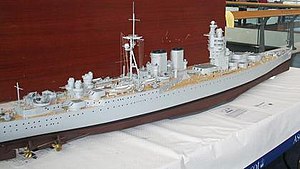G3 battlecruiser

A 1:96 scale model of a G3 battlecruiser
|
|
| Class overview | |
|---|---|
| Name: | G3 |
| Operators: |
|
| Preceded by: | Admiral class |
| Succeeded by: | None |
| Planned: | 4 |
| Completed: | 0 |
| Cancelled: | 4 |
| General characteristics (as of November 1921) | |
| Type: | Battlecruiser |
| Displacement: |
|
| Length: | 856 ft (260.9 m) |
| Beam: | 106 ft (32.3 m) |
| Draught: | 35 ft 8 in (10.9 m) (at deep load) |
| Installed power: |
|
| Propulsion: |
|
| Speed: | 32 knots (59 km/h; 37 mph) |
| Range: | 7,000 nautical miles (13,000 km; 8,100 mi) at 16 knots (30 km/h; 18 mph) |
| Complement: | 1716 |
| Armament: |
|
| Armour: | |
The G3 battlecruisers were a class of battlecruisers planned by the Royal Navy after the end of World War I in response to naval expansion programmes by the United States and Japan. The four ships of this class would have been larger, faster and more heavily armed than any existing battleship (although several projected foreign ships would be larger). The G3s have been considered to be proper "fast battleships" since they were well-balanced designs with adequate protection. Nonetheless the class was officially designated as a "battlecruiser" due to their higher speed and lesser firepower and armour relative to the planned N3 class battleship design. The G3s carried nine 16-inch (406 mm) guns and were expected to achieve 32 knots (59 km/h; 37 mph), while the N3s would carry nine 18-inch (457 mm) guns on the same displacement at the expense of a slower speed.
The G3 design was approved by the Board of Admiralty on 12 August 1921. Orders were placed in October, but were suspended in mid-November shortly after the beginning of the Washington Naval Conference which limited battleship sizes. The orders were cancelled in February 1922 with the ratification of the Washington Naval Treaty which limited construction to ships of no more than 35,000 long tons (36,000 t) displacement.
In 1916 the US had declared its intention to create a Navy "second to none"; the United States Congress had authorized the building of a large number of battleships and battlecruisers. In the aftermath of the First World War, the Japanese government were also embarking on a large programme of warship building. Meanwhile, in Great Britain, the needs of the First World War had led to the pre-war Queen Elizabeth-class battleships being followed by the slower and cheaper Revenge class. Two improved Revenge-class hulls were converted during construction into the two Renown-class battlecruisers as emergency builds during the war. The only new capital ships laid down in the war were the Admiral-class battlecruisers. Their design had been called into question after the Battle of Jutland in 1916. Three of this class were cancelled, leaving only Hood to be completed to an altered design.
...
Wikipedia
